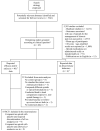Outcomes associated with opioid use in the treatment of chronic noncancer pain in older adults: a systematic review and meta-analysis
- PMID: 20533971
- PMCID: PMC3114446
- DOI: 10.1111/j.1532-5415.2010.02920.x
Outcomes associated with opioid use in the treatment of chronic noncancer pain in older adults: a systematic review and meta-analysis
Abstract
This systematic review summarizes existing evidence regarding the efficacy, safety, and abuse and misuse potential of opioids as treatment for chronic noncancer pain in older adults. Multiple databases were searched to identify relevant studies published in English (1/1/80-7/1/09) with a mean study population age of 60 and older. Forty-three articles were identified and retained for review (40 reported safety and efficacy data, the remaining 3 reported misuse or abuse outcome data). The weighted mean subject age was 64.1 (mean age range 60-73). Studies enrolled patients with osteoarthritis (70%), neuropathic pain (13%), and other pain-producing disorders (17%). The mean duration of treatment studies was 4 weeks (range 1.5-156 weeks), and only five (12%) lasted longer than 12 weeks. In meta-analyses, effect sizes were -0.557 (P<.001) for pain reduction, -0.432 (P<.001) for physical disability reduction, and 0.859 (P=.31) for improved sleep. The effect size for the Medical Outcomes Study 36-item Health Survey was 0.191 (P=.17) for the physical component score and -0.220 (P=.04) for the mental component score. Adults aged 65 and older were as likely as those younger than 65 to benefit from treatment. Common adverse events included constipation (median frequency of occurrence 30%), nausea (28%), and dizziness (22%) and prompted opioid discontinuation in 25% of cases. Abuse and misuse behaviors were negatively associated with older age. In older adults with chronic pain and no significant comorbidity, short-term use of opioids is associated with reduction in pain intensity and better physical functioning but poorer mental health functioning. The long-term safety, efficacy, and abuse potential of this treatment practice in diverse populations of older persons remain to be determined.
Figures
Comment in
-
In older adults with chronic non-cancer pain, short-term use of opioids reduces pain and physical disability but does not benefit mental health, and 25% discontinue due to adverse effects.Evid Based Nurs. 2011 Oct;14(4):111-2. doi: 10.1136/ebn1173. Epub 2011 Jun 18. Evid Based Nurs. 2011. PMID: 21685502 No abstract available.
Similar articles
-
Hydromorphone for cancer pain.Cochrane Database Syst Rev. 2016 Oct 11;10(10):CD011108. doi: 10.1002/14651858.CD011108.pub2. Cochrane Database Syst Rev. 2016. Update in: Cochrane Database Syst Rev. 2021 Aug 5;8:CD011108. doi: 10.1002/14651858.CD011108.pub3. PMID: 27727452 Free PMC article. Updated.
-
Antidepressants for pain management in adults with chronic pain: a network meta-analysis.Health Technol Assess. 2024 Oct;28(62):1-155. doi: 10.3310/MKRT2948. Health Technol Assess. 2024. PMID: 39367772 Free PMC article.
-
Oxycodone for neuropathic pain in adults.Cochrane Database Syst Rev. 2016 Jul 28;7(7):CD010692. doi: 10.1002/14651858.CD010692.pub3. Cochrane Database Syst Rev. 2016. PMID: 27465317 Free PMC article.
-
Adverse events associated with medium- and long-term use of opioids for chronic non-cancer pain: an overview of Cochrane Reviews.Cochrane Database Syst Rev. 2017 Oct 30;10(10):CD012509. doi: 10.1002/14651858.CD012509.pub2. Cochrane Database Syst Rev. 2017. PMID: 29084357 Free PMC article.
-
Methadone for neuropathic pain in adults.Cochrane Database Syst Rev. 2017 May 17;5(5):CD012499. doi: 10.1002/14651858.CD012499.pub2. Cochrane Database Syst Rev. 2017. PMID: 28514508 Free PMC article.
Cited by
-
The Role of Opioid Analgesics in Geriatric Pain Management.Clin Geriatr Med. 2016 Nov;32(4):725-735. doi: 10.1016/j.cger.2016.06.006. Epub 2016 Aug 9. Clin Geriatr Med. 2016. PMID: 27741966 Free PMC article. Review.
-
Opioids in geriatric units in 14 Belgian hospitals: prevalence, dosage and associated factors.Ann Med. 2024 Dec;56(1):2310132. doi: 10.1080/07853890.2024.2310132. Epub 2024 Jan 31. Ann Med. 2024. PMID: 38294956 Free PMC article.
-
Diagnostic and Predictive Capacity of the Spanish Versions of the Opioid Risk Tool and the Screener and Opioid Assessment for Patients with Pain-Revised: A Preliminary Investigation in a Sample of People with Noncancer Chronic Pain.Pain Ther. 2022 Jun;11(2):493-510. doi: 10.1007/s40122-022-00356-2. Epub 2022 Feb 7. Pain Ther. 2022. PMID: 35128624 Free PMC article.
-
Investigating the Association of Pain Intensity and Health Status among Older US Adults with Pain Who Used Opioids in 2020 Using the Medical Expenditure Panel Survey.Healthcare (Basel). 2023 Jul 12;11(14):2010. doi: 10.3390/healthcare11142010. Healthcare (Basel). 2023. PMID: 37510451 Free PMC article.
-
Associations of Early Opioid Use With Patient-reported Outcomes and Health Care Utilization Among Older Adults With Low Back Pain.Clin J Pain. 2018 Apr;34(4):297-305. doi: 10.1097/AJP.0000000000000557. Clin J Pain. 2018. PMID: 28915153 Free PMC article.
References
-
- Kalso E, Edwards JE, Moore A, et al. Opioids in chronic non-cancer pain: systematic review of efficacy and safety. Pain. 2004;112:372–380. - PubMed
-
- Avouac J, Gossec L, Dougados M. Efficacy and safety of opioids for osteoarthritis: A meta-analysis of randomized controlled trials. Osteoarthritis Cartilage. 2007;15:957–965. - PubMed
-
- Eisenberg E, McNichol ED, Carr DM. Efficacy and safety of opioid agonists in the treatment of neuropathic pain of nonmalignant origin. JAMA. 2005;293:3043–3052. - PubMed
-
- Martell BA, O’Connor PG, Kerns RD, et al. Systematic review: Opioid treatment for chronic back pain: Prevalence, efficacy, and association with addiction. Ann Intern Med. 2007;146:116–127. - PubMed
Publication types
MeSH terms
Substances
Grants and funding
LinkOut - more resources
Full Text Sources
Medical


